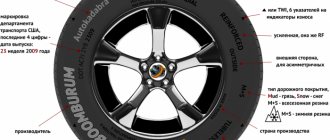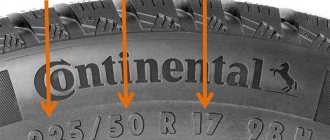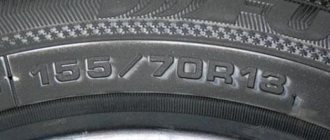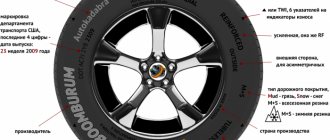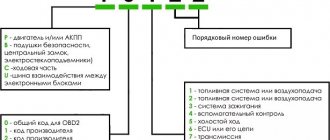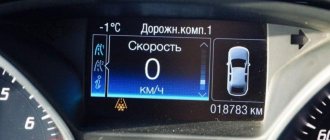A lot depends on the right choice of shoes for your car. When deciding to purchase a kit, you can be guided by various comparative tests. However, it is worth remembering that their characteristics must correspond to operating conditions. In this case, the information indicated in the markings on the sidewall of the tire will help. Such inscriptions on the tire indicate the size of the product and its technological characteristics. Below we will decipher the symbols and try to figure out what the numbers and letters in the rubber markings mean.
Where to indicate the standard size and its interpretation
Tire markings have mandatory and optional designations.
So, on each tire the manufacturing company, the brand of the rubber itself and the tire size will be indicated. The three-digit designation on tires indicates the wheel size in inches, tire width and profile height. The numbers are located on the outside. We have a wheel with parameters, for example, 195 60 R16. This means that we have tires in front of us with a tread width of 195 mm. The second number is the ratio of the picture's height to its width. The higher this parameter, the more “grippy” the tire will be. This value is usually called the profile indicator. The third number is the tire's inner diameter in inches. In general, a common mistake is that motorists purchase wheels without paying attention to some data on changes in external parameters. For example, size 185 65 r15 will differ in height from 210 65 r15 with the same bore diameter. The ratio of the profile to the width in our case may interfere with the installation of tires on the car. This factor should be understood and taken into account. A special calculator will help you correctly calculate tire sizes.
Symbols for correct rubber installation
In addition to deciphering the inscriptions on tires, the second most important are special symbols that allow you to correctly mount the tire.
Rotation
This symbol can be present in the form of an inscription or an arrow. It shows the direction of rotation of the tire. If you put the arrow in the other direction, the rubber will experience increased wear and will quickly fail.
Outside
An important indicator for tubeless tires. Translated from English, the word means “external”. This means the side of the rubber that should be on the outside. Otherwise, such a tire will not hold pressure.
Inside
If there is an external side, then there is also an internal side. This is also used in conjunction with the previous designation.
Outer and inner side of the tire
It is important to ensure that the direction of the rubber and the installation rules are followed at the tire shop.
Date of issue
Any rubber product has an expiration date. After this period, the rubber becomes hard, cracks and loses its properties. The same thing happens with tires: the older the tire, the greater the chance that it will burst while driving. To calculate whether the rubber is suitable for further use, you need to know the date of its manufacture, which is stamped in two ways:
- In the form of three numbers - an outdated version.
- In the form of four numbers - a modern version.
In the first version there is an oval, inside of which there are numbers. The first two digits are the week of manufacture, the last one corresponds to the final digit of the year. For example, 469 means the tire was produced in November 2022 or 2009.
Problems with deciphering the year led to a new version of the production date. Now it is printed as four numbers in the same oval. The first two digits are the week, the second two correspond to the year.
Speed indices
Also, tire manufacturers are required to provide all tires with a speed index. This sign can be found immediately after the wheel size indicator. It talks about the maximum speed you can travel on the roads. A table that deciphers the speed index of passenger car tires will help you read this sign correctly.
| Tire classification by speed | |||||||||
| Designation | N | P | Q | R | S | T | U | H | V |
| Speed | 140 | 150 | 160 | 170 | 180 | 190 | 200 | 210 | 240 |
Installation procedure.
There are unique asymmetric tires and a number of others that require certain installation conditions, then the marking indicates how and where exactly the tire should be installed. Main options:
- the outer part of the asymmetric tire - the inscription Outside or Side Facing Out;
- the inner part of the asymmetric tire – Inside or Side Facing Inwards;
- direction of rotation of the directional tire – arrow and the inscription Rotation;
- the tire is installed only on the left side - the inscription Left;
- The tire is installed exclusively on the right side - the inscription Right.
Load indices
Immediately after the speed index on the car tires there is an index of the permissible load on each wheel. For example, the tire marking contains the indicator 88t. This indicates that the car can travel at a maximum speed of 190 km/h, and the maximum permissible load on each wheel is 560 kg.
On certain tires you can find designations in the form of the letters XL or the word Reinforced. This marking is usually awarded to tires whose load index is higher than standard values. If the number 88 is written on the sidewall of an xl or extra load tire, then add 3 to the value. deciphering this figure costs 91 or 615 kg per wheel.
| Digital designation | load in kg one wheel for passenger cars |
| 60-70 | 250-335 |
| 71-80 | 345-450 |
| 81-90 | 462-600 |
| 91-100 | 615-800 |
| 101-110 | 825-1060 |
| 111-120 | 1090-1400 |
| 121-129 | 1450-1850 |
Technical characteristics and design features.
Most manufacturers indicate the technical characteristics and design features of the tires in the tire labeling, and also put certain marks. Let's start with RSC (RunFlat System Componen) technology. To put it simply, these tires can travel a certain distance after damage, i.e. at low speed (up to 80 km/h) you can drive up to 150 km with a flat tire. Various manufacturers have their own markings for such tires, for example:
- DSST - Dunlop;
- ZP SR or ZP – Michelin;
- Run Flat – Nokian;
- RFT-Bridgestone;
- RunOnFlat - Goodyear;
- SSR - Continental.
Now let's look at the basic notations:
- tubeless tire – Tubeless or TL;
- tire that must be used with a tube - MIT SCHLAUCH, Tube Type, or TT;
- reinforced tire, several options are used - Reinf, XL (Extra Load) Reinforced or the letters RF;
- tires with a radial design - Radial;
- The tire uses a metal cord – Steel;
- retreaded tire - Retread;
- the maximum permissible tire pressure, measured in kPa – MAX PRESSURE;
- maximum permissible load on one tire in kg or pounds - Max Load;
- TWID or TWI (tread wear index) – indicates the location of the tread indicator;
Some markings indicate the composition of the tire. Look for the inscription Plies: and a transcript of the information:
- Tread area – information about what the tread is made of, for example, Nylon and Steel (nylon and steel);
- Sidewall – information about what the sidewall is made of, for example, Nylon.
The degree of rim protection may also be indicated (usually on low-profile tires - there is a disc protection rib). Main markings:
- rim without protection – FB (flat base);
- rim with protection – FR (flange protector);
- rim with protection against damage in collisions with sidewalks and curbs - MFS - (Maximum Flange Sheild) or RPB (Rim Protection Bar).
The latest feature from manufacturers is tires that save fuel. They are designated differently - you may see Green X or Reduces CO2.
Decoding of the American standard size designation
American tire manufacturers resort to different tire markings. The first one is very similar to the European one, only before the dimension there are additional letters P - passenger, LT - light truck or T - truck. For example, 185 r14c P means that this is a wheel with a tread width of 185 mm, a diameter of 14 inches and intended for passenger cars.
The second system for classifying its products has a completely different look. If the European system measures the dimensions of car tires in millimeters, then the American system measures the dimensions of car tires in inches. However, it is quite simple to understand. For example, there are numbers on tires 27*11*r15. The first number is the outer diameter of the tire, the second is the tread width, and the last number is the inner diameter.
About the manufacturers
In fact, when choosing tires, many car enthusiasts rely on the brands that manufacture the products. We list the most famous brands:
- Michelin;
- Dunlop;
- Pirelli
- Bridgestone;
- Heidenau;
- Metzeler;
- IRC;
- Continental;
- etc.
There is a popular belief that brand fame affects the quality of the product. But in practice, experienced motorists will say that this is not entirely true. Unfortunately, this is primarily due to the fact that European brands tend to make tires in underdeveloped countries. Typically, these include Taiwan and Serbia. Therefore, quality indicators will differ from the initial indicators that are typical for production in Europe itself.
Additionally, it is worth listing less popular brands, but at the same time periodically found on our market:
- Sava;
- Mitas;
- Cheng Shin;
- Kenda;
- AvonShinco;
- Duro;
- Maxxis;
- and etc.
It is also worth noting the seasonality of tires. They can be:
- Summer;
- Winter;
- All-season.
Color-coded tire markings
To facilitate the installation of wheels on rims, manufacturers sometimes equip them with additional color marks that carry their own information. How to decipher such icons is below.
Yellow tire markings
Sometimes you can see a yellow dot or triangle on tires, which means the lightest place on the tire. When mounting, it is necessary to align the mark with the heaviest part of the disk to facilitate balancing.
Red rubber markings
Additional tire parameters include the red circle or triangle symbols that can be found on the sidewall of the rubber. This is the designation of the hardest point of the tire wall. It must be combined with o on the disk.
White stamp with a number
A white stamp with a number located on the outer side carries information about the inspector who carried out the final “acceptance” of the goods.
Color stripes
Some tires have radial colored stripes. They help identify tires of certain brands in the store and quickly search for them in the warehouse. Sometimes the color of the strip indicates the date of manufacture or the country of manufacture, and also indicates that it has been run-in.
Date of manufacture
Even without being installed on a car, rubber loses its properties over time. If tires are stored in a warehouse for a long time, they lose their elasticity and, accordingly, their driving characteristics.
You can calculate the tire's release date by looking at the DOT marking. The last 4 digits of the American code, enclosed in a semi-oval, indicate the week and year of production. For example, if this number is 2216, then the tire left the factory in week 22 of 2016.
Additional inscriptions on the sidewall of the tire
On many passenger tires, in addition to the model designation and tread type, there is additional marking:
- the letter R indicates that the tires are of a radial design - older models are designated by other letters;
- the presence of the word steel in the design means the presence of steel cord;
- An E in a circle indicates compliance with European ece requirements;
- Aqua – tires with improved behavior on wet asphalt and in aquatred aquacontact rain conditions;
- TL (TubeLess) - tubeless tire; in the absence of this marking, a tube is required;
- Outside – the outside of the installation. Differs from the inner sides with an asymmetric tread. It will help you figure out which side should be on the outside when installing a set of tires on a car;
- DOT - compliance with the safety requirements of standardization countries;
- Rotation - applied to sets with a directional pattern. The wheels should rotate in the direction indicated by the arrow;
- Treadwear is an indicator of wear resistance. Many tires have wear markings in the form of grooves. An increased number of layers is indicated by the letter C;
- RF (RunFlat) - rubber with reinforced cord. Capable of traveling more than 80 km at the lowest pressure - 0 atmospheres. There are cases when both punctured wheels held the road well at speeds of up to 80 km/h.
Seasonality
It's also worth understanding what the seasonal badges on wheels mean.
- Winter – designation of winter tires. It has a soft rubber composition, and some tires are equipped with 1.6 mm high studs, which provide better traction on icy roads;
- M+S badges are found on many winter and summer kits. This marking stands for Mud+Snow. The tires have a pronounced pattern and are able to perform well in bad weather conditions. However, universal tires behave worse than profile sets.
Date of manufacture
Next to the wheel size there are four more numbers indicating the date of manufacture of the set. It's quite easy to read if you understand the calendar. The first two digits are the serial number of the week, and the second are the year of production. That is, number 4215 indicates that the kit was produced in the 42nd week of 2015.
The expiration date of Bridgestone car tires - how to determine?
Bridgestone car tires are of high quality due to modern materials and innovative technologies used in the production of the tread. But, like all car tires, after a certain period of use they lose their performance characteristics, reducing the safety of movement. The appearance of microcracks, fractures, and uneven wear are the first signs of the condition of the tire structure.
The shelf life of standard tires is 5–6 years of fruitful use from the date of manufacture, and not from the date of purchase. Although, depending on the driving style, road and climatic conditions, the correctness/accuracy of balancing and even the technical serviceability of the suspension, this parameter may change, however, in the direction of decreasing rather than increasing mileage.
Each type of Bridgestone tire has its own expiration date according to GOST. Thus, high-speed ZR models operated at high speeds retain their properties for a maximum of 6 years, tires with the H index (up to 210 km/h) work quietly for 4–5 years, and tires with the S index (maximum speed up to 180 km /h) function optimally for 4 years. In order to have a complete understanding of what year the tires were produced, it is enough to carefully study the stamp on the side of the model - the first digits/week of production, the second digits/year of production. Knowing the exact production time, it is not difficult to calculate how many seasons a tire will last if used correctly.
What factors affect tire life?
In most cases, the shelf life of Bridgestone tires is influenced by several significant factors, most often directly dependent on the driver of the vehicle.
- Degree of vehicle congestion - for example, summer tires on passenger cars and when driving in city mode do not wear out as quickly as similar models installed on light trucks intensively used for various cargo transportation.
- Car tire size - tires will wear out faster when driving around sharp turns, having a wider profile, while low-profile models wear out more when driving on poor-quality roads.
- Driving style - aggressive driving, dashing turns and “police” turns, sharp braking and acceleration affects the degree of wear on the Bridgestone tire tread and not for the better.
- The quality of the road surface is a factor on which the shelf life directly depends; driving on smooth asphalt roads in a calm driving manner increases the shelf life, while aggressive driving and poor quality of the road surface reduces it.
- And naturally, the mileage of the tire - after four to five seasons of operation, each driver can already visually determine that it is time to change the tires.
In all cases, only the car owner is responsible for the service life and safety characteristics, and only he can determine that it is time to replace and buy new tires in order to get the highest level of performance, reliability, safety and comfort on every trip.
If you receive the text, click on the social media button


